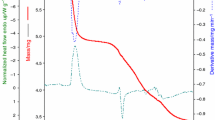Abstract
The thermally induced interactions of sodium alendronate trihydrate in 1:1 mass ratio binary mixture with talc, silica, magnesium stearate, microcrystalline cellulose, starch, gelatin and mannitol were studied under non-isothermal conditions. The heat flow (HF) signal, obtained by converting the temperature differences (DTA) into power units, was used for detecting the thermally induced events. By all the seven excipients, no thermally induced interactions with alendronate were observed, but the thermal stability of the excipients is very different. The talc and silica, as expected, are very thermostable. By starch, gelatin, and microcrystalline cellulose, the HF signal corresponding to the thermo degradation is over 270 °C, the deamination step of alendronate. The magnesium stearate and mannitol substances are not recommended for solid formulation due to its low thermal stability.









Similar content being viewed by others
References
Chen M, Liu K, Zhong D, Chen X. Trimethylsilyldiazomethane derivatization coupled with solid-phase extraction for the determination of alendronate in human plasma by LC-MS/MS. Anal Bioanal Chem. 2012;402:791–8.
Chen B, et al. Zoledronic acid enhances bone-implant osseointegration more than alendronate and strontium ranelate in ovariectomized rats. Osteoporos Int. 2013;24:2115–21.
Chen BL, et al. Comparison of the effects of alendronate sodium and calcitonin on bone-prosthesis osseointegration in osteoporotic rats. Osteoporos Int. 2011;22(1):265–70.
Atyol UK, et al. The influence of low-level laser therapy with alendronate irrigation on healing bone defects in rats. Lasers Med Sci. 2015;30:1141–6.
Bruni G, et al. Drug-excipient compatibility studies in binary and ternary mixtures by physico-chemical techniques. J Therm Anal Calorim. 2010;102:193–201.
Marx RE. Pamidronate (Aredia) and Zoledronic acid (Zometa) induced a vascular necrosis of the jaws: a growing epidemic. J Oral Maxilofac Surg. 2003;61:1115–7.
Migliorati CA. Bisphosphonates and oral cavity avascular bone necrosis. J Clin Oncol. 2003;21:4253–4.
Weinstein RS, Chambers TM, Hogran EA, Webb WW, Wicker CA, Manolagos SC. Giant osteoclast formulation after long term oral aminobisphosphonate therapy for postmenopausal osteoporosis. Honoluluy: American Society of Bone and Mineral Research; 2007.
Allen MR, Burr DB. Mandible matrix necrosis in beagle dogs after 3 years of daily oral bisphosphonate treatment. J Oral Maxilofac Surg. 2008;66:984–94.
American Dental Association. Dental management of patients receiving oral bisphosphonate therapy-expert panel recommendations, Report of Council on Scientific Affairs; 2008.
Albu P, Doca SC, Anghel A, Vlase G, Vlase T. Thermal behavior of sodium alendronate. A kinetic study under non-isothermal conditions. J Therm Anal Calorim (in press) (JTAC-D-15-01731R1).
Fulias A, Ledeti I, Vlase G, Vlase T. Physico-chemical solid-state characterization of pharmaceutical pyrazolones: an unexpected thermal behaviour. J Pharm Biomed. 2013;81–82:44–9.
Ledeti I, Vlase G, Vlase T, Ciucanu I, Olariu T, Fulias A, Suta LM, Todea A. Instrumental analysis of potential lovastatin-excipient interactions in preformulation studies. Rev Chim. 2015;66(6):879–82.
Ledeti I, Vlase G, Vlase T, Fulias A. Kinetic analysis of solid-state degradation of pure pravastatin versus pharmaceutical formulation. J Therm Anal Calorim. 2015;121(3):1103–10.
Ledeti I, Vlase G, Vlase T, Suta LM, Todea A, Fulias A. Selection of solid-state excipients for simvastatin dosage forms through thermal and nonthermal techniques. J Therm Anal Calorim. 2015;121(3):1093–102.
Fulias A, Ledeti I, Vlase G, Popoiu C, Heghes A, Bilanin M, Vlase T, Gheorgheosu D, Craina M, Ardelean S, Ferechide D, Marginean O, Mos L. Thermal behaviour of procaine and benzocaine Part II: compatibility study with some pharmaceutical excipients used in solid dosage forms. Chem Cent J. 2013; 7:art 140.
Zhang T, Howell BA, Smith PB. Thermal degradation of glycerol/adipic hyperbranched poly(ester)s containing either hydroxyl or carboxyl end groups. J Therm Anal Calorim. 2015;122:1221–9.
Acknowledgements
Iulia CEBAN (PhD student) was cofinanced in this work from the European Social Fund through Sectoral Operational Programme Human Resources Development 2007–2013, Project Number POSDRU/187/1.5/S/155559, Competitive Multidisciplinary Doctoral Research in Europe. Paul Albu (PhD) was supported by strategic Grant POSDRU/159/1.5/S/133391.
Author information
Authors and Affiliations
Corresponding author
Rights and permissions
About this article
Cite this article
Doca, S.C., Albu, P., Ceban, I. et al. Sodium alendronate used in bone treatment. J Therm Anal Calorim 126, 189–194 (2016). https://doi.org/10.1007/s10973-016-5619-z
Received:
Accepted:
Published:
Issue Date:
DOI: https://doi.org/10.1007/s10973-016-5619-z




